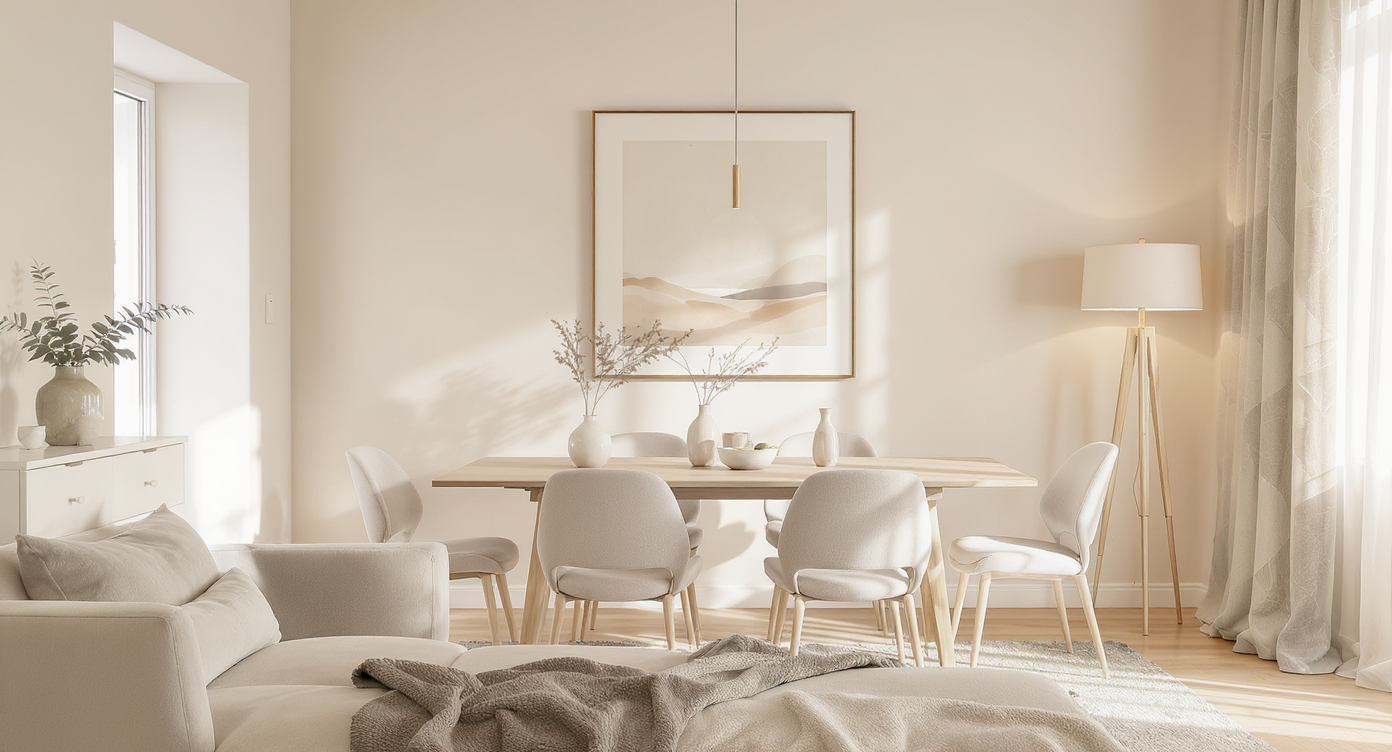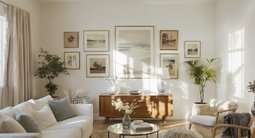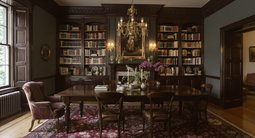TL;DR
If your living room feels almost there but a little flat, focus on four finishing touches: a right-size area rug, layered ambient lighting, varied heights and shapes, and personal color cues from art or nature. Use this as a practical guide for how to finish a neutral living room without starting from scratch.
The Secret to Making a Neutral Living Room Feel Complete

Simple finishing touches like art and lighting transform a neutral space without adding clutter.
I hear the same quiet question every week: What’s missing? Someone sends photos of a serene, beige-on-beige living-dining space, carefully curated and spotless. It’s tranquil, yes. But something’s not singing. Here’s the thing: finishing touches are not about buying more. They’re about balance, warmth, and intention. Budgets are tighter, sustainability matters more, and personal stories beat fast trends. In 2025, living room decor succeeds when design feels like participation, not perfection. I’ve seen a room transform with a single oversized rug and a dimmer switch. I’ve watched a tiny dining mirror swapped for a large art print, instantly grounding the space and making dinners feel like an occasion. If you love a neutral palette, keep it. These tweaks just make it feel finished.
The Case for Finishing Touches in Neutral Living Rooms
Balanced rooms share three traits: a defined floor plan, soft layered light, and contrast in color and texture. Designers often advise a 60-30-10 color ratio and at least three light sources per zone to keep neutral spaces from feeling sterile. Think of your living room as two stages: floor and glow. The floor anchors your furniture with an area rug that’s sized to the seating and dining areas. The glow comes from lamps and warm bulbs that soften recessed lighting. With those set, use scale, shape, and a few personal colors to add soul. Short-tail keywords to guide your choices: living room decor, finishing touches, area rug, ambient lighting, indoor plants. Long-tail ideas to search: how to add color to a beige living room, best size rug for living room under sofa, how to layer lighting in a living room.
Anecdote
A minimalist client once asked why her neutral room still felt cold. We added a 9x12 rug, two paper floor lamps, and scaled her art up to a single large piece. She texted that night: We didn’t add stuff. We added feeling.
DIY Hacks & Tricks
01. The Oversized Area Rug Rule
A large area rug visually unifies seating and adds warmth; aim for front sofa legs on the rug and at least 8 to 12 inches of floor showing around the perimeter.
What it is: The quickest way to define zones and add texture. In open plans, one big rug can stop the eye from bouncing and make the room feel intentional.
How it works: For living areas, experts recommend an 8x10 or 9x12 so the rug catches the front legs of major seating and extends near the coffee table. For dining, add roughly 24 inches beyond the table on all sides so chairs stay on the rug when pulled out. Natural fiber rugs like wool, jute, or flatweave cotton add organic texture without shouting.
- Tip 1: Tape out the size with painter’s tape before buying.
- Tip 2: If everything is beige, try a vintage-style rug with muted terracotta, sage, or teal to add quiet color.
- Tip 3: Use a rug pad cut 1 inch smaller on all sides to prevent curling.
02. Layered Ambient Lighting Plan
Use three layers of light per zone: ambient, task, and accent, with warm bulbs at 2700K to 3000K and dimmers to control mood.
What it is: A mix of floor lamps, table lamps, and a pendant over the dining table to soften harsh ceiling cans and add evening coziness.
How it works: Recessed lights can create scallops on walls that feel like a showroom. Add two floor lamps flanking the sofa, a petite table lamp on a console, and a pendant centered over the table. Aim for 1,500 to 3,000 lumens total in a seating area, spread across fixtures. If cans have gimbals, aim them into the room, not down the walls.
- Tip 1: Choose fabric shades or rice paper globes for softer diffusion.
- Tip 2: Install dimmers to shift from task to ambient in seconds.
- Tip 3: Hide cords with adhesive raceways or baseboard channels.
03. Color That Still Feels Calm
Follow the 60-30-10 rule: 60 percent base neutrals, 30 percent supporting tones, and 10 percent accent color pulled from existing art or nature.
What it is: A strategic way to add life to a beige living room without repainting or abandoning minimalism.
How it works: Sample colors from your wall art or plants. Soft teal from a print, a sunset orange from dried florals, or a dusty green from eucalyptus adds depth. Carry that color from floor to eye level via a rug, two pillows, a throw, and a small lamp base for continuity, not random pops.
- Tip 1: Repeat the accent at least three times in the room.
- Tip 2: Mix values of the same hue, like sage, olive, and pine.
- Tip 3: Rotate seasonally with pillow covers and table runners.
04. Vary Heights and Shapes
Break the rectangle rut by adding one tall element 6 to 7 feet high and at least one round or oval form in each view.
What it is: A fix for rooms where everything sits at the same height and shape, which flattens the composition.
How it works: Use a tall plant on an 8 inch stand, an arched floor lamp, or a slim bookcase to lift the eye. Add round pillows, a pedestal side table, or an oval rug to soften angles. Triangular groupings and odd-number clusters feel more dynamic than straight lines of small objects.
- Tip 1: Elevate shorter plants on stands to stagger foliage heights.
- Tip 2: Swap a square coffee table for a smaller round one to improve flow.
- Tip 3: Group decor in threes with varied heights for balance.
05. Scale Up Art and Mirrors
Art above a sofa should be about two-thirds the width of the sofa, centered around 57 inches at eye level; mirrors look best when they reflect light or a view.
What it is: Right-sizing wall decor so it grounds furniture rather than floating away.
How it works: If a mirror feels small over a dining table, replace it with one large art piece or a grid of four frames. Over consoles, mirrors usually read best when their width is 1/2 to 2/3 the furniture width. Don’t be afraid of big art on the TV wall either; oversize pieces can calm visual clutter.
- Tip 1: Hang art 6 to 8 inches above a sofa back.
- Tip 2: Use heavier frames to add contrast on pale walls.
- Tip 3: Align pieces with ceiling can lights to avoid awkward scallops.
06. Texture, Texture, Texture
Aim for at least five distinct textures in a neutral living room to keep it from feeling sterile.
What it is: Layering materials like linen, boucle, leather, rattan, terracotta, and wood grain so neutrals feel rich, not flat.
How it works: Add curtain panels in textured linen, a nubby throw, a ribbed ceramic lamp base, and a woven tray. Even small shifts help: swapping slick planters for matte clay, or adding a rattan shade. Curtains hung high and wide also add softness and height.
- Tip 1: Mix matte and sheen for depth, such as clay with glazed ceramic.
- Tip 2: Use warm bulbs to emphasize texture shadows.
- Tip 3: If trim is missing, simple baseboards instantly finish the room.
07. Rebalance The Layout
Distribute visual weight: leave 36 inches for main walkways and 16 to 18 inches between sofa and coffee table for comfort.
What it is: Small layout edits that make the room feel less crammed on one side and empty on the other.
How it works: If the sofa, art, and plants all live on one wall, consider flipping the seating and media wall or floating the sofa with a slim console behind it. In dining areas, a round or oval table can soften corners and improve flow. One impactful floor lamp or tall cabinet near the TV wall adds height where it’s lacking.
- Tip 1: Center pendants over tables, not merely over existing can lights.
- Tip 2: Choose one larger coffee table or a small pedestal instead of multiple pieces.
- Tip 3: Let at least the front sofa legs sit on the living rug to unite the zone.
08. Plant Power With Presence
Use fewer, larger indoor plants for impact: one statement tree 6 to 7 feet tall plus two medium plants beats many tiny ones.
What it is: Greenery that acts like sculpture and brings real color to a neutral palette.
How it works: Elevate medium plants on 6 to 10 inch stands to vary heights. Choose fuller leaves to offset angular furniture, and place plants where they catch light rather than glare. A single generous arrangement on the dining table often looks better than several small vases.
- Tip 1: Cluster in odd numbers for a natural look.
- Tip 2: Match planter proportions to plant size, roughly one-third plant height.
- Tip 3: Use saucers and felt pads to protect floors.
Suggested image alt-text and captions:
- Alt: Neutral living room with oversized rug unifying sofa and coffee table. Caption: An 8x10 rug anchors seating and adds instant warmth.
- Alt: Dining nook with pendant light centered over round table. Caption: Layered lighting defines zones and softens recessed cans.
- Alt: Gallery wall scaled two-thirds the sofa width. Caption: Larger art calms the composition and grounds furniture.
What Ties These Ideas Together
What ties these ideas together isn’t just frugality. It’s intention. I’ve seen beige rooms stay beautifully neutral yet feel transformed when the rug finally fits, the lamps glow warm, and the art grows up a size. Every tweak here adds warmth without clutter, and every imperfection becomes part of the charm.
Visualize Before You DIY
Before you move furniture or pick a new rug, visualize your ideas. ReimagineHome lets you upload a photo of your space and test colors, furniture, lighting, and textures in seconds. Try a larger rug, swap a mirror for art, or add a pendant over the table virtually, then refine scale and palette before you buy. It’s not just inspiration - it’s a confidence tool for every creative homeowner.
Visualization Scenario
Upload a photo of your lounge to ReimagineHome, try a 9x12 rug and a sculptural pendant, then toggle lamp warmth from 2700K to 3000K to see how texture comes alive.
FAQ
How should I place an area rug in a living room?
Place the rug so front legs of sofas and chairs sit on it, leaving 8 to 12 inches of floor around the room’s edge for a frame.
What size rug do I need under a dining table?
Choose a rug that extends about 24 inches beyond the table on all sides so chairs stay on the rug when pulled out.
How do I add color to a beige living room without repainting?
Pull one hue from art or plants and apply the 60-30-10 rule with pillows, throws, a lamp base, and a patterned rug for subtle contrast.
How do you layer lighting in a living room?
Use ambient, task, and accent lighting together with warm 2700K to 3000K bulbs and dimmers for flexibility day to night.
How high should I hang art or a mirror above a sofa or console?
Center art around 57 inches from the floor; hang pieces 6 to 8 inches above a sofa and size width to roughly two-thirds of the furniture below.
How can I fix a room that feels unbalanced on one side?
Distribute visual weight by flipping the seating and media wall, adding a tall element to the lighter side, and using a large rug to unify zones.
Wrap Up
In 2025, finishing touches are less about decorating and more about storytelling. A right-size area rug says this is where we gather. Lamps say stay awhile. Bigger art says this room has presence. Your accent colors whisper where you’ve been and what you love. Keep the serene base if it centers you. Then add scale, light, texture, plants, and a few meaningful hues so your living room looks like it belongs to a person, not a catalog. When you’re ready to test variations risk-free, try them first in ReimagineHome and bring the best version to life.
.svg)

.svg)
.jpg)







.png)